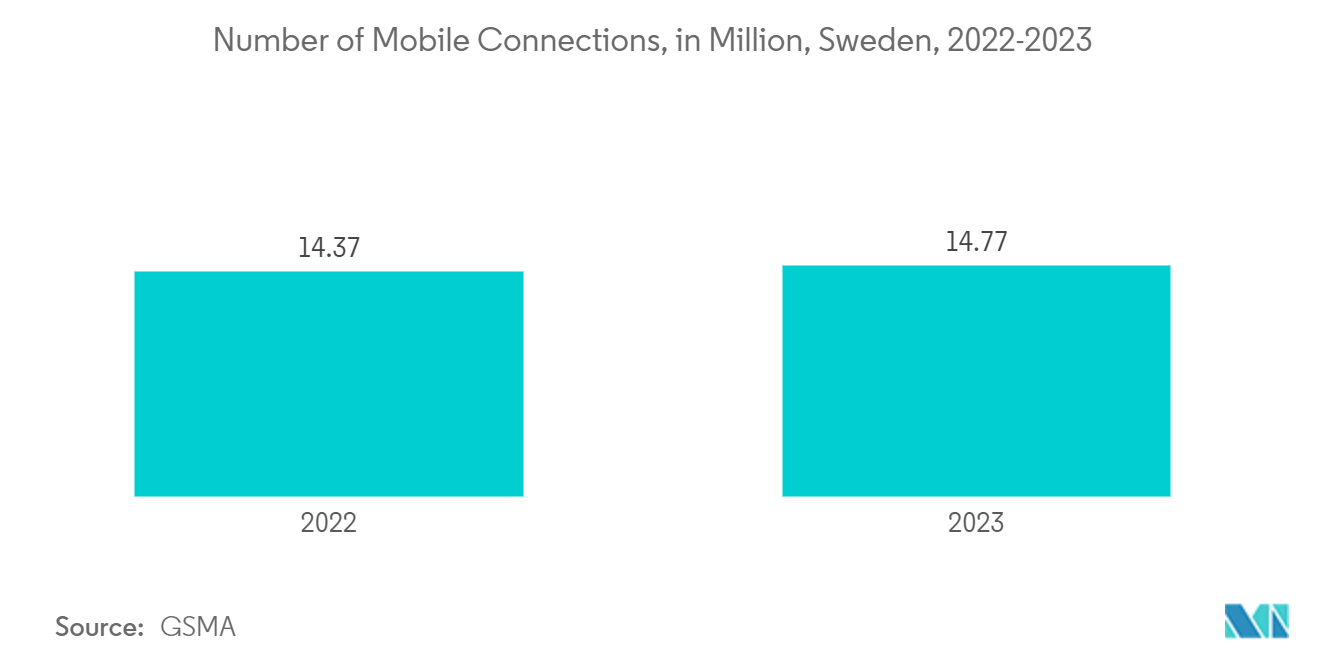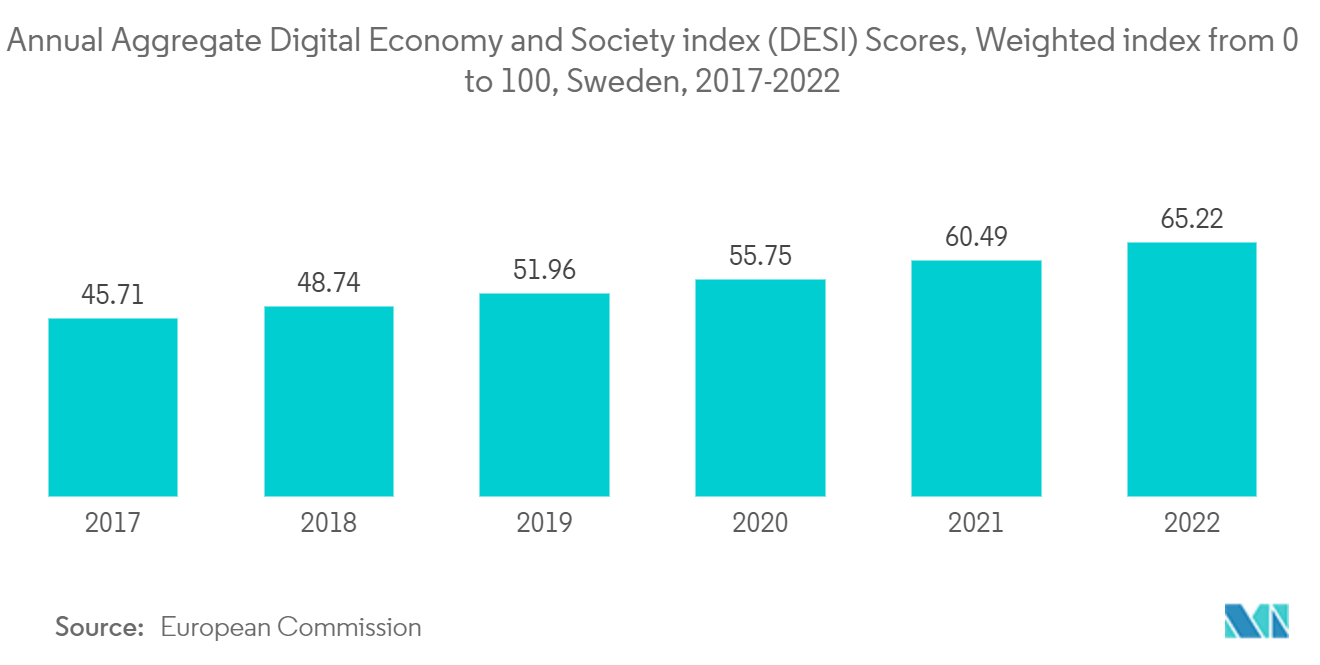Market Trends of Stockholm Data Center Industry
Tier 4 is Expected to Hold Significant Share of the Market
- The tier-IV certification is currently the highest classification among data center facilities. These data centers require huge capital compared to other tiered data centers and are usually present in developed economies. Sweden is still a developing data center market with an internet penetration of about 50%. The low-tiered data centers in Sweden more feasibly handle the amount of traffic generated. The companies have shown less interest in having facilities with tier IV status in the region.
- Major companies, like Microsoft and Amazon, which operate massive data centers in other regions, have restricted their operations to lower-tiered data centers in Stockholm. Companies like NTT have shown interest in having tier IV facilities in the future. Still, significant investments and expansions have been more toward tier II and III data centers. Moreover, tier-IV providers have redundancies (2N+1) for every process and the data protection stream. No single outage or error can shut down the system and provide 99.9 % uptime annually, the highest guaranteed uptime. The level IV infrastructure should have at least 96 hours of independent power to qualify in this tier. This power should not be connected to any outside source and should be entirely proprietary.
- This tier also ensures optimized efficiency. The servers are housed in the most physically advantageous locations. This drastically extends the life of the hardware. If temperature and humidity are kept consistent, one can gain great efficiency. Even backups and dual power sources are treated like primary sources. Also, the tier-IV data center can require up to 3 to 1 of the space required to facilitate the IT footprint. For tier IV, the kW cost component is USD 25,000 per kW of the redundant UPS capacity for IT.
- Tier IV is considered an enterprise-level service. Companies without international reach and consistently high web traffic do not usually require Tier IV facilities. Tier IV has As technological advancements, such as AI, IoT, and 5G, are leading the digital transformation, various industry sectors, such as government, finance, media, and manufacturing, are starting to demand advanced data centers with high reliability. By leveraging their years of expertise, only some prominent technological vendors in the region are launching services allowing end-users to better manage data center operations.
- According to GSMA Intelligence, Sweden had 14.77 million cellular mobile connections by the beginning of 2023. Further, mobile connections in Sweden were comparable to 139.6 percent of the population in January 2023. The trends in mobile technology, particularly smartphones, have had a significant impact on the data center industry. With the proliferation of mobile devices and the rise in mobile data usage, data centers have had to adapt to handle the increasing demand for mobile services.

Retail Colocation Center is Expected to Hold Significant Share
- Retail colocation is where the customer leases space within the data center, such as rack space within the caged-off area. Owing to various advantages, such as economics and ease of maintenance, smaller enterprises generally prefer retail colocation. Owning a data center is not a viable option due to the cost of land leasing. Also, maintenance of a colocation center is often outside budget constraints.
- The high demand for colocation services from developing countries drives the retail colocation market. Compared to wholesale colocation services, retail colocation services are highly suitable for enterprises requiring less computing power at one site or across multiple locations to benefit local and global customers. The retail colocation market is anticipated to grow significantly during the forecast period. About 100 kW of energy is typically needed to power retail data centers, while wholesale customers usually need more than 100 kW, owing to their business scale. Many facilities, such as security provision, customer support, cooling facilities, etc., are provided by colocation suppliers.
- Typically, retail customers have many partners to maintain connectivity. Therefore, a diverse set of carriers with good speeds is necessary. Additionally, as retail data center providers work with more clients than wholesale providers, their facilities usually offer a multitude of networks and services. Retail providers offer various services, such as smart hands and remote hands, for technical assistance, managed services, and network monitoring. Therefore, resolving issues can be as simple as raising a service ticket. Such services help exploit various other benefits, such as locating data centers away from disaster-prone areas that can be remotely operated. Due to this remote hand's technology, tax benefits in different states can be used to avail certain tax benefits.
- Many new technologies, including 100% green data centers, have been deployed in retail colocation. Aruba SPA has built a 100% green data center facility. This facility uses underground flowing rivers to turn turbines, solar panels, and underground water pumped to the surface for cooling. The need for interconnectivity is also increasing, increasing the demand for retail colocation. It has been identified that the leading providers of colocation services offer as many as 230,000 interconnection possibilities. Many SME industries constitute a large part of the economy. Such SMEs can only afford part of the space for utility, as the IT staff and operations are included in this scale of operation.
- According to the European Commission, the annual aggregate digital economy and society index (DESI) scores of SWDEN increased to 65.22 in 2022 from 45.71 in 2017. Such a rise in digital scores would allow the study market to grow. Since retail colocation facilities have become old and outdated, their customers are choosing to leave these facilities to find other, newer, multi-tenant data center providers. When retail colocation facilities lose customers, this presents itself in their customer churn metrics. Indeed, public data center companies report churn metrics quarterly, with higher churn implying that more customers are leaving.


